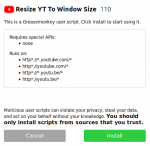Greasemonkey Manual:Installing Scripts: Difference between revisions
No edit summary |
m Moved heading levels down here |
||
| Line 1: | Line 1: | ||
{{Greasemonkey Manual TOC}} | {{Greasemonkey Manual TOC}} | ||
= About User Scripts = | == About User Scripts == | ||
The purpose of [[Greasemonkey]] is to manage [[user script]]s. | The purpose of [[Greasemonkey]] is to manage [[user script]]s. | ||
| Line 19: | Line 19: | ||
If the URL of a link you click, or otherwise navigate to, ends with <code>.user.js</code>, then [[Greasemonkey]] will intercept the loading file, and present its installation dialog. | If the URL of a link you click, or otherwise navigate to, ends with <code>.user.js</code>, then [[Greasemonkey]] will intercept the loading file, and present its installation dialog. | ||
= The Installation Dialog = | == The Installation Dialog == | ||
[[Image:Install-dialog.png|thumb|150 px|Greasemonkey Installation Dialog]] | [[Image:Install-dialog.png|thumb|150 px|Greasemonkey Installation Dialog]] | ||
| Line 40: | Line 40: | ||
This bar includes an install button, which, like the button in the prior dialog, will also install the script. | This bar includes an install button, which, like the button in the prior dialog, will also install the script. | ||
= See Also = | == See Also == | ||
* Shared script repository: http://userscripts.org/ | * Shared script repository: http://userscripts.org/ | ||
Revision as of 12:27, 15 December 2007
 Greasemonkey Manual |
| Using Greasemonkey |
|---|
| Installing Scripts |
| Monkey Menu |
| Getting Help |
| User Script Authoring |
| Editing |
| Environment |
| API |
About User Scripts
The purpose of Greasemonkey is to manage user scripts. User scripts allow the user to control the way they use the web, by customizing it with scripting. Greasemonkey won't do any good without any scripts installed. So, the first thing an eager user should do is find and install (or write!) a useful script.
First, a word on finding user scripts. They may be located anywhere, on the internet or off. The Greasemonkey community, however, most often uses the general-purpose user scripting site created for it: http://userscripts.org/.
To install a script, navigate to it it with Firefox after installing Greasemonkey. This is most often done by clicking a link on a web page, but you may also drag-and-drop a local file into a Firefox window, or use the "File, Open..." dialog to open it.
An aside: What is a user script?
Any file that ends in .user.js is a user script.
If the URL of a link you click, or otherwise navigate to, ends with .user.js, then Greasemonkey will intercept the loading file, and present its installation dialog.
The Installation Dialog

Whenever you navigate to a user script as described above, Greasemonkey will open its installation dialog, instead of loading the script like a normal page. A thumbnail of this dialog is shown to the right. It displays the name and description of the script, if available, as well as the include and exclude rules that apply.
The install button will, of course, install the script in question. Like the Firefox extension install dialog, the install button is disabled for a few seconds, to avoid the same potential security vulnerability. Likewise, the cancel button will perform the obvious action.
The third button is the View Script Source button, and will also perform the obvious action that the name implies. At this point, Greasemonkey has already downloaded the user script in question, to display the name and other details. When you ask Greasemonkey to show you the script source, it shows you the temporary file that it has already downloaded, as in this screenshot. This, also, is intentionally engineered to avoid a potential security problem, wherein an evil server could deliver one innocent script, for viewing, and on the second load an evil script, for installing. This approach ensures that the script is downloaded only once, and that if you examine the source of a script, that is the script you will install.
Finally, in this view script source dialog, there is an info bar, similar to the extension installation security warning. This bar includes an install button, which, like the button in the prior dialog, will also install the script.
See Also
- Shared script repository: http://userscripts.org/